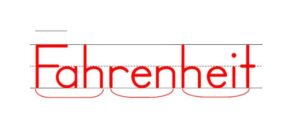Red Words: You Know You Love Them!
One of our participants’ favorite strategies is our Red Word Strategy! This is a strategy that everyone is able to see working in their classroom, no matter the age or population, which may explain why it’s usually the first strategy that teachers implement in their classrooms.
Easy-to-follow steps can be found on the Blue Flip Chart, and the Red Word section in the Training Manual can help you find words to use if you don’t already have a list.
Why does this strategy work so well?
Here are a few reasons:
- Teachers help students identify what is irregular about the word. What is unexpected in the spelling?
- Teachers use www.etymonline.com to figure out the history of a word to see if it can give students insight as to why it’s spelled that way. This resource is excellent for lexical words (words that hold meaning) compared to functional words.
- Humans remember best when items are “chunked” in 4 or fewer digits (social security, phone numbers, etc.). In IMSE’s strategy, we “chunk” words so that there are no more than 4 chunks per section, such as “Fah ren heit”

- Motor muscle memory is a powerful tool used to help remember words. Just like a dancer can remember a dance without thinking about it after much practice, students can remember the word by retapping it on their arm for body memory.
- Students have a better chance of remembering something when you verbalize it 10-20 times than if you read it 50-100 times. We verbalize a minimum of 10 times for each red word.
- Students can remember items better when presented in song. When we verbalize the spelling of the word, we chant or cheer the letters.
- For each Red Word, students use their eyes, voice, hands, and ears, so they are using the visual, auditory and tactile (kinesthetic) learning modalities.
- Red Word steps go from gross motor (standing and arm tapping) to fine motor (writing).
Visualization
Another great strategy to use is visualization. Have your students close their eyes and visualize the word in chunks. Have them visualize tracing those chunks. Then have them try to spell the word out loud while their eyes are closed. Students with dyslexia are often great visual learners, so this may help them.
Be sure to follow the steps on your Blue Flip Chart until you are comfortable with it. Please contact your trainer if you have any questions!
